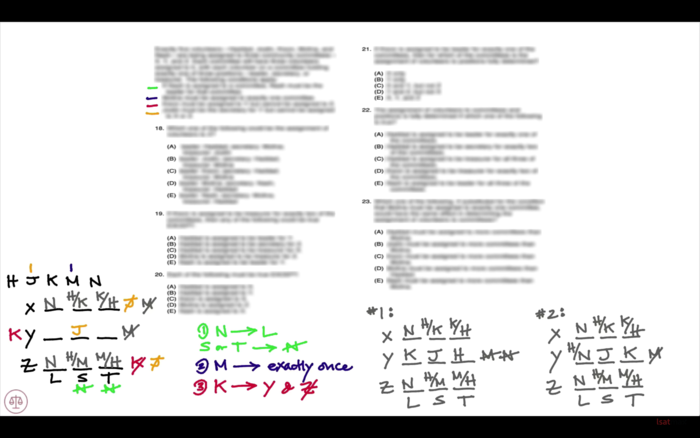Okay so before we move to the conditions here, let's draw out our setup. We know that we are going to be placing five volunteers: Haddad, Jocelyn, Kwon, Molina and Nash in three committees: X, Y and Z. Each of these committees has three positions: leader, secretary and treasurer. You notice we have a grouping game here. We're going to place these five volunteers into these three committees, and again, keeping in mind that each of these committees has three positions: leader, secretary and treasurer.
Turning our attention now to the first condition, “If Nash is assigned to a committee, Nash must be the leader for that committee.” We know “if” introduces sufficient, so if Nash is on a committee Nash must be the leader. Contrapositive, if it's not the leader, stated another way, if we are secretary or treasurer, it can't be Nash. So the contrapositive here leads to a great deduction, that Nash is not going to be secretary or treasurer. If Nash appears, Nash must be the leader.
Moving to the second condition, “Molina must be assigned to exactly one committee.” So we know that M is appearing exactly once. You notice at this point we really don't know much about the numerical distribution. We have no idea how many times each of these volunteers appears. Are they appearing once? Are they appearing more than once? Here, we get our first clue towards that with condition number two telling us that Molina is appearing exactly once.
Moving on to the third condition here, which tells us “Kwon must be assigned to Y but cannot be assigned to Z.” We know that Kwon must be assigned to Y and it cannot be assigned to Z. So Kwon cannot be present for Z, but Kwon must be present for Y.
And our fourth and final condition here, “Jocelyn must be the secretary for Y but cannot be assigned to X or Z.” We know that Jocelyn must be the secretary for Y and we know that Jocelyn cannot appear in X and Jocelyn cannot appear in Z. Notice that also tells us that Jocelyn's appearing exactly once. Jocelyn's only going to appear in committee Y. Now, let's see what deductions we can make.
First, I want to turn my attention here to committee Z because you notice of the five volunteers two have been eliminated which means we know the three volunteers for committee Z: H, M and N. We know that when N is present N is the leader. So in Z, N will be the leader. We're going to have reverse dual options of H and M then for S and T. Notice now we have placed our only M, which tells us that M cannot appear in committee Y or committee X. Now you notice again for committee X, we have eliminated two of the five volunteers, so the only possibilities that remain for X are H, K and N. Again, we know if N is present N is the leader. We're going to have reverse dual options of H and K for secretary and treasurer in committee X.
Turning my attention here to committee Y, which is the only one that we haven't filled out completely, notice that we must place Kwon still, which mean Kwon is either going to be the leader or Kwon is going to be the treasurer. Let's draw out these two scenarios here just to make sure we have them clear. Placing what we already know in scenario one, now I'm going to place K as the leader for Y. If K is the leader for Y, now again we know M is not going to be present, but we also know now that N can't be present because the only spot open is treasurer and with treasurer, we know it can't be N. That means N is out, so the only possibility that exists in this scenario for treasurer for committee Y is H.
Drawing out our second possibility here now where we're going to place Kwon as the treasurer in Y. Again, placing what we already know, now Kwon will be the treasurer for Y, which means the only possibilities that now exist, we know M is not going to be present, so it must be H or N, either of which is possible.
You notice here this is a GURU game. We are able to draw out all of the possible scenarios here. Now that we've done this, this game will be a breeze. Let's turn our attention to the questions.










